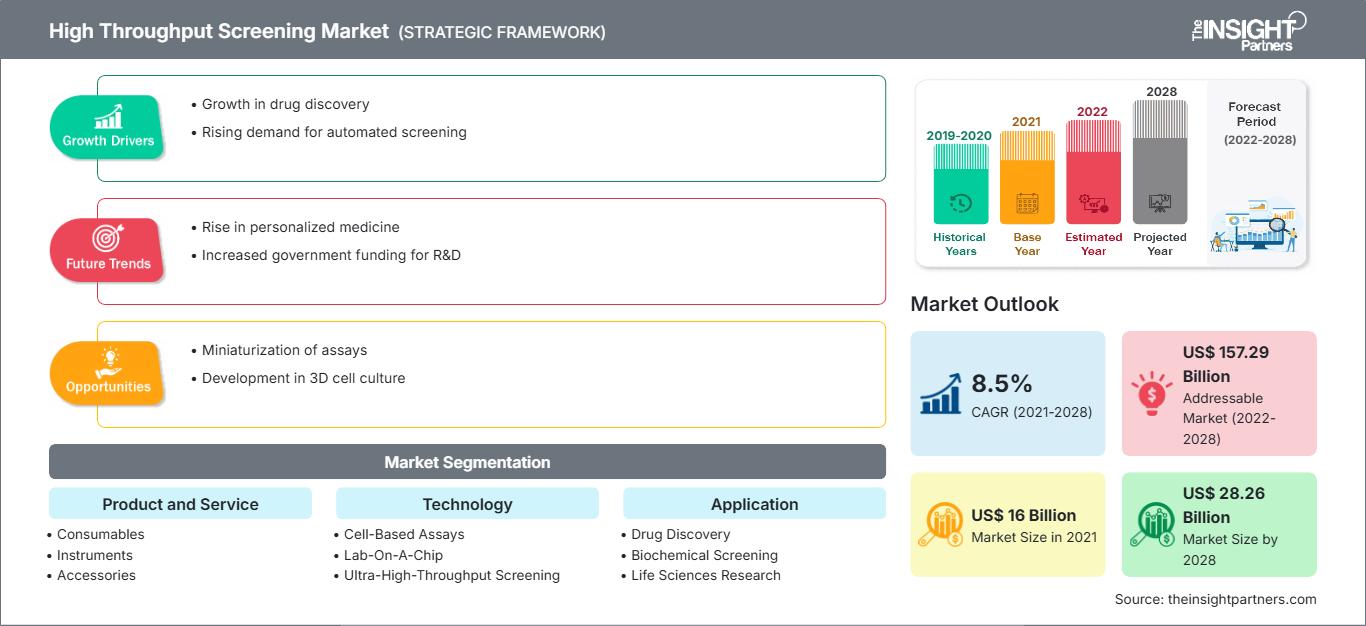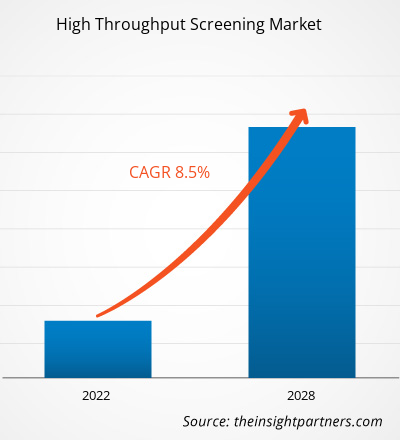Se prevé que el mercado de cribado de alto rendimiento alcance los 28.255,71 millones de dólares estadounidenses en 2028, frente a los 15.997,47 millones de dólares estadounidenses en 2021. Se estima que el mercado crecerá con una tasa de crecimiento anual compuesta (TCAC) del 8,5% entre 2021 y 2028.
El cribado de alto rendimiento (HTS, por sus siglas en inglés) es un método de descubrimiento de fármacos que permite el análisis automatizado de diversos compuestos químicos o biológicos para una diana biológica específica. Los métodos de cribado de alto rendimiento se utilizan ampliamente en la industria farmacéutica, aprovechando la robótica y la automatización para analizar rápidamente la actividad biológica o bioquímica de un número significativo de moléculas, generalmente fármacos. Aceleran el análisis de dianas, ya que permiten cribar rápidamente bibliotecas de compuestos a gran escala de forma rentable. El HTS es una herramienta valiosa para evaluar dianas farmacológicas, perfilar farmacológicamente agonistas y antagonistas de receptores (como los GPCR) y enzimas. Se espera que factores como el aumento de la inversión en investigación y desarrollo por parte de la industria farmacéutica y biotecnológica y la introducción de productos tecnológicamente avanzados en el mercado del cribado de alto rendimiento impulsen el crecimiento del mercado en los próximos años. Sin embargo, el elevado coste del cribado de alto rendimiento, la escasez de profesionales cualificados y la complejidad en el desarrollo de ensayos probablemente frenen el crecimiento del mercado en los próximos años.
Perspectivas del mercado
Aumento de la inversión en investigación y desarrollo por parte de la industria farmacéutica y biotecnológica
El aumento de la inversión en I+D por parte de las empresas farmacéuticas y biotecnológicas, junto con importantes líneas de desarrollo de fármacos para el tratamiento de diversas enfermedades crónicas, como trastornos cardiovasculares, cáncer, trastornos inmunológicos, metabólicos y neurológicos, son factores clave para el mercado del cribado de alto rendimiento. Numerosas empresas farmacéuticas, tanto grandes como pequeñas, participan en el desarrollo y la fabricación de nuevas moléculas para diversas enfermedades potencialmente mortales. Esto ha propiciado la elección de métodos automatizados de cribado de alto rendimiento (HTS) para analizar extensas bibliotecas químicas y satisfacer las necesidades de un número cada vez mayor de moléculas diana farmacológicas. Por ejemplo, un sistema automatizado de cribado de alto rendimiento puede analizar entre 10 000 y 100 000 compuestos diana en un solo día. Las empresas farmacéuticas y biotecnológicas han invertido considerablemente en técnicas de cribado de alto rendimiento durante la última década. Por ejemplo, la reconocida alianza entre Millennium Pharmaceuticals, Inc. y Bayer AG ha descubierto con éxito 18 nuevas dianas farmacológicas y ha sometido cuatro de ellas a cribado de alto rendimiento en menos de ocho meses. Esta alianza adopta un novedoso enfoque de producción basado en la investigación genómica para acelerar al máximo la llegada de las moléculas a los ensayos clínicos. El cribado de alto rendimiento (HTS, por sus siglas en inglés) se considera una tecnología fundamental en el proceso de descubrimiento de fármacos. Por ejemplo, más del 60 % de los programas de optimización de estructuras líderes de Boehringer Ingelheim, ya desarrollados, se deben a la implementación exitosa del HTS. Solo en Estados Unidos, se invierten anualmente más de 2500 millones de dólares en productos y servicios de HTS. Las grandes farmacéuticas invierten hasta 35 millones de dólares anuales en tecnologías de cribado. Una proporción significativa de estas inversiones se destina al desarrollo de nuevos ensayos.
Obtendrá personalización gratuita de cualquier informe, incluyendo partes de este informe, análisis a nivel de país y paquetes de datos de Excel. Además, podrá aprovechar excelentes ofertas y descuentos para empresas emergentes y universidades.
Mercado de cribado de alto rendimiento: Perspectivas estratégicas

-
Obtenga las principales tendencias clave del mercado que se describen en este informe.Esta muestra GRATUITA incluirá análisis de datos, que abarcarán desde tendencias de mercado hasta estimaciones y pronósticos.
El creciente número de dianas farmacológicas para el cribado, utilizado en el descubrimiento y desarrollo de fármacos, junto con las crecientes inversiones de gobiernos e institutos de investigación, impulsarán aún más la adopción de técnicas de cribado de alto rendimiento (HTS). Por ejemplo, en diciembre de 2020, Sygnature Discovery, una organización independiente de investigación preclínica y descubrimiento de fármacos con sede en el Reino Unido, invirtió alrededor de 4,12 millones de dólares estadounidenses para fortalecer su servicio de cribado de alto rendimiento (HTS) y oncología traslacional. Además, programas como «Toxicología en el siglo XXI», una iniciativa conjunta de la FDA, la Agencia de Protección Ambiental y los Institutos Nacionales de Salud de EE. UU., utilizan HTS automatizado para analizar sustancias químicas, formulaciones y fármacos ambientales, realizar un examen toxicológico exhaustivo y desarrollar vías específicas asociadas a la enfermedad para predecir los niveles toxicológicos. Estas iniciativas favorecerán la expansión del mercado del cribado de alto rendimiento.
Información basada en productos y servicios
Según el tipo de producto y servicio, el mercado de cribado de alto rendimiento se clasifica en consumibles, instrumentos, accesorios, software y servicios. En 2021, el segmento de consumibles representó la mayor cuota de mercado y se prevé que experimente la mayor tasa de crecimiento anual compuesto (TCAC) durante el período de pronóstico.
Cobertura del informe
Perspectivas basadas en la tecnología
Según la tecnología empleada, el mercado de cribado de alto rendimiento se segmenta en ensayos celulares, sistemas de laboratorio en chip, cribado de ultra alto rendimiento, bioinformática y tecnología sin marcadores. En 2021, el segmento de ensayos celulares ostentó la mayor cuota de mercado, mientras que se prevé que el segmento de sistemas de laboratorio en chip experimente el mayor crecimiento anual compuesto durante el periodo de previsión.
Información basada en aplicaciones
Según su aplicación, el mercado de cribado de alto rendimiento se segmenta en descubrimiento de fármacos, cribado bioquímico, investigación en ciencias de la vida y otras aplicaciones. En 2021, el segmento de descubrimiento de fármacos representó la mayor cuota de mercado y se prevé que experimente el mayor crecimiento anual compuesto (CAGR) durante el período de pronóstico.
Información basada en el usuario final
Según el usuario final, el mercado de cribado de alto rendimiento se segmenta en empresas farmacéuticas y biotecnológicas, instituciones académicas y gubernamentales, organizaciones de investigación por contrato (CRO) y otros. En 2021, el segmento de empresas farmacéuticas y biotecnológicas ostentó la mayor cuota de mercado, mientras que se prevé que el segmento de organizaciones de investigación por contrato (CRO) experimente el mayor crecimiento anual compuesto (CAGR) durante el período de pronóstico.
Varias empresas que operan en el mercado de cribado de alto rendimiento están adoptando estrategias como lanzamientos de productos, fusiones y adquisiciones, colaboraciones, innovaciones de productos y ampliaciones de cartera de productos para expandir su presencia en todo el mundo, mantener su marca y satisfacer la creciente demanda de los usuarios finales.
Perspectivas regionales del mercado de cribado de alto rendimiento
Los analistas de The Insight Partners han explicado en detalle las tendencias regionales y los factores que influyen en el mercado de cribado de alto rendimiento durante el período de previsión. Esta sección también analiza los segmentos y la geografía del mercado de cribado de alto rendimiento en Norteamérica, Europa, Asia Pacífico, Oriente Medio y África, y Sudamérica y Centroamérica.
Alcance del informe de mercado de cribado de alto rendimiento
| Atributo del informe | Detalles |
|---|---|
| Tamaño del mercado en 2021 | 16 mil millones de dólares |
| Tamaño del mercado para 2028 | US$ 28.260 millones |
| Tasa de crecimiento anual compuesto global (2021 - 2028) | 8,5% |
| Datos históricos | 2019-2020 |
| período de previsión | 2022-2028 |
| Segmentos cubiertos |
Por producto y servicio
|
| Regiones y países cubiertos |
América del norte
|
| Líderes del mercado y perfiles de empresas clave |
|
Densidad de participantes en el mercado de cribado de alto rendimiento: comprensión de su impacto en la dinámica empresarial
El mercado de cribado de alto rendimiento está creciendo rápidamente, impulsado por la creciente demanda de los usuarios finales debido a factores como la evolución de las preferencias de los consumidores, los avances tecnológicos y una mayor concienciación sobre las ventajas del producto. A medida que aumenta la demanda, las empresas amplían su oferta, innovan para satisfacer las necesidades de los consumidores y aprovechan las nuevas tendencias, lo que impulsa aún más el crecimiento del mercado.

- Obtenga una visión general de los principales actores del mercado de cribado de alto rendimiento.
Mercado de cribado de alto rendimiento: por producto y servicio
-
Consumibles
- Reactivos y kits de ensayo
- Equipo de laboratorio
-
Instrumentos
- Sistemas de manejo de líquidos
- Sistemas de detección
- Accesorios
- Software
- Servicios
Mercado de cribado de alto rendimiento – por tecnología
- Ensayos basados en células
- Laboratorio en un chip
- Cribado de ultra alto rendimiento
- Bioinformática
-
Tecnología sin etiquetas
- Resonancia de plasmones superficiales
- Interferometría reflectiva
- Calorimetría de titulación isotérmica
- Calorimetría diferencial de barrido
- Microcantileveres
- Nanotubos de carbono
- Cristales fotónicos
- Otros
Mercado de cribado de alto rendimiento: por aplicación
- Descubrimiento de fármacos
- Detección bioquímica
- Investigación en ciencias de la vida
- Otras aplicaciones
Mercado de cribado de alto rendimiento – por usuario final
- Empresas farmacéuticas y biotecnológicas
- Instituciones académicas y gubernamentales
- Organizaciones de Investigación por Contrato (CRO)
- Otros
Mercado de cribado de alto rendimiento – por geografía
-
América del norte
- A NOSOTROS
- Canadá
- México
-
Europa
- Francia
- Alemania
- Italia
- Reino Unido
- España
- El resto de Europa
-
Asia Pacífico (APAC)
- Porcelana
- India
- Corea del Sur
- Japón
- Australia
- Resto de Asia Pacífico
-
Oriente Medio y África (MEA)
- Sudáfrica
- Arabia Saudita
- Emiratos Árabes Unidos
- Resto de Oriente Medio y África
-
Sudamérica (SAM)
- Brasil
- Argentina
- El resto de Sudamérica y Centroamérica
Perfiles de empresas
- Agilent Technologies, Inc.
- Spa Axxam
- Eurofins Scientific
- Corning Incorporated
- Dispositivos moleculares, LLC.
- Compañía Hamilton
- Grupo Merck
- Perkinelmer, Inc.
- Grupo Tecan
- Thermo Fisher Scientific Inc.
- Análisis histórico (2 años), año base, pronóstico (7 años) con CAGR
- Análisis PEST y FODA
- Tamaño del mercado, valor/volumen: global, regional y nacional
- Industria y panorama competitivo
- Conjunto de datos de Excel
Informes recientes
Testimonios
Razón para comprar
- Toma de decisiones informada
- Comprensión de la dinámica del mercado
- Análisis competitivo
- Información sobre clientes
- Pronósticos del mercado
- Mitigación de riesgos
- Planificación estratégica
- Justificación de la inversión
- Identificación de mercados emergentes
- Mejora de las estrategias de marketing
- Impulso de la eficiencia operativa
- Alineación con las tendencias regulatorias






















 Obtenga una muestra gratuita para - Mercado de cribado de alto rendimiento
Obtenga una muestra gratuita para - Mercado de cribado de alto rendimiento